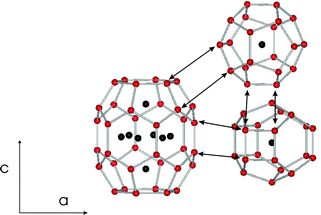A big water cage, sH clathrate hydrate
What does it look like?

The three host water cages found in sH clathrate hydrates and how they fit together. Image from Loveday and Nelmes 2008 http://pubs.rsc.org/en/content/articlelanding/2008/cp/b704740a#!divAbstract
What is it?
Water is an incredible material for lots of reasons, but a further one is the sheer number of materials it will form new compounds with. Known as hydrates, we've featured quite a lot of them on the blog so far. Most of the time the water molecules are able to bond with the materials it's forming with, for instance in copper sulfate hydrate. But sometimes water forms a solid with a material it can't bond to, often very small organic molecules like methane and propane, so what do those structures look like?
We've met these before, a class of materials called clathrate hydrates. These are three-dimensional host guest materials where the water molecules form into a giant host cage that trap the small molecular guests. The structure we met before was one of the two cubic (i.e. very symmetrical) clathrates that form when you freeze methane and water. This one is a bit different. It's named sH clathrate, where the H indicates that it has hexagonal symmetry, and is special because it forms a very big cage able to fit some pretty large molecules in.
It was thought for many years that this material was only synthetic; it was discovered in the laboratory. This structure has been of interest to a range of scientists, especially as it could also be used to stored CO2. But a few years ago researchers plumbing the margins of the Gulf of Mexico discovered that the hexagonal big cage form of clathrate could form in nature too.
Where did the structure come from?
sH clathrate hydrates were first discovered by Ripmeester et al., and were reported in Nature in 1987.






